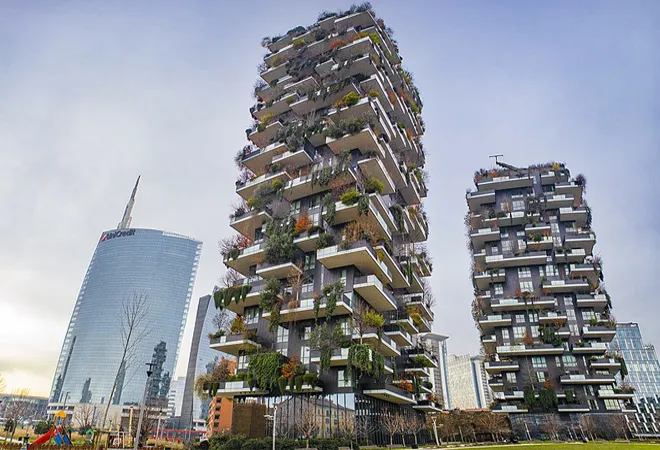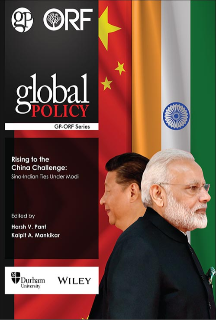
Recently, India’s first vertical forest came up in Bengaluru. It is a step towards greener cities but it begs the question: Why have cities like Delhi and Mumbai, with high pollution levels, not adopted this concept yet?
Mumbai is the country’s financial capital and is one of the most advanced metro cities in India. But with the city’s popularity comes the problem of high population influx, congestion and pollution. This city, with an ever-increasing population, can only expand vertically to ease congestion. Mumbai leads India’s vertical construction trend with the highest number of high-rise structures. The common problem faced by most cities is that of haphazard development. Mumbai falls amongst the top ten most populated cities. While policy-makers have to cater to the needs of the ever-increasing population, the planners need to keep in mind the concept of sustainability. This article advocates the need for incorporating greenery into Mumbai’s development projects by looking at one such concept of green infrastructure — the vertical forest.
The vertical forest system emerged in 2014 as part of a redevelopment project in Milan. The vertical forest project, or Bosco Verticale in Italian, are a pair of residential towers that also house 900 trees and over 10,000 plants and shrubs. Vertical forests are a way of urban reforestation and are key towards allowing humans and various other species to coexist. The pollution mitigation and biodiversity boosting nature of the vertical forest soon gained popularity across the world, especially in mega-cities with poor air quality. The cities of Nanjing, Singapore and Sydney stand out for their remarkable green architecture that promote the adoption of vertical forests.
Several land use-land cover studies in Mumbai have shown that the green cover of the city is reducing.
Mumbai’s distribution, in terms of the built-up area, changed massively between 1972 and 2011. The built-up area — which consists of various residential, institutional, educational and industrial buildings — expanded from 234 sq km to 1,056 sq km with a corresponding influx in population. Although nearby areas started to develop due to pressure on the mainland, the overall environment deteriorated. Areas with abundant greenery were lost to the built-up area. Several land use-land cover studies in Mumbai have shown that the green cover of the city is reducing. The ratio of green spaces to total area fell from 46.7 per cent in 1988 to 26.67 per cent in 2018.
The natural area lost to built-up area over time results in an increase in the land surface temperature of the city. Land surface temperature will rise over time if global warming is not controlled. Rising land surface temperature adversely affects biodiversity, increases pollution and results in heat waves.
With the threat of rising sea levels, frequent floods, high pollution levels and increasing population, the pressure to incorporate sustainability in development plans is high. Here, the concept of the vertical forest is a possible solution to one of the many problems faced by the city. Vertical forests act as a carbon sink by absorbing carbon dioxide emissions, increasing energy efficiency and the level of oxygen. The urban heat island effect arising from human activities can be offset by building vertical forests in high-risk areas of the city. For example, after the vertical forest construction in Milan, the city witnessed an improvement in air quality, increase in biodiversity and a significant reduction in the heat island effect. The Nanjing green towers in Nanjing, China, are being constructed with the intent of absorbing 25 tonnes of carbon dioxide a year and producing about 60 kilogram of oxygen per day.
Vertical forests act as a carbon sink by absorbing carbon dioxide emissions, increasing energy efficiency and the level of oxygen.
In times where not just the frequency but also the intensity of natural disasters is rising, it is extremely important to think of a sustainable urban future. Forests have numerous benefits. Even the urban forest, which includes trees planted along the streets, contribute to mitigating air pollution. Mumbai has a large area covered by forest. The Sanjay Gandhi National Park hosts various species of birds, animals and insects and the Aarey forests are the green lungs of Mumbai. Despite a fair share of the city being covered by forests, the air quality index of Mumbai has worsened over time. This underscores the need for vertical forests and other green spaces across the city.
It takes several years for forests to grow naturally and just a few months to destroy them completely. Deforestation affects the air, water and soil quality. Cutting down trees in an area for infrastructure creation and compensating for the damage by planting an equivalent number of trees elsewhere will never provide the same environmental value. Besides, the time taken to fully grow trees is so long that during the interim period, there is irreversible damage to the environment. The decision of declaring the Aarey area as ‘reserved forests’ pushed Mumbai towards being just one step away from a downward spiral on the climate front.
The last time city planners discussed the idea of vertical forests was in 2015, when a few drawbacks caused experts to abandon the idea. One cause of concern was the high concentration of steel and concrete in such towers. But there are new infrastructural developments being undertaken in Mumbai that do more harm than good to the condition of the city’s environment. As of 2020, Mumbai falls within the top 25 cities with the largest number of skyscrapers, with 53 skyscrapers around the city. Apart from the construction of smaller residential and institutional buildings, the construction of 44 additional skyscrapers in Mumbai is already underway.
The time taken to fully grow trees is so long that during the interim period, there is irreversible damage to the environment.
Other countries adopting the concept of the vertical forest have already created a base for experimentation and put forward a few ways in which the vertical forest can be improved. Urban planners of the city should keep this in mind while undertaking infrastructure projects such as the vertical forest to avoid repeating mistakes made by other countries. The projects should be modified as per the geography of the city. To implement the concept of vertical forests in Mumbai, a cost-benefit analysis should be undertaken keeping in mind the already deteriorating climatic conditions and future threats to the city.
The government, while working on development projects, needs to think of the repercussions in the future and make decisions accordingly. Projects need to have respect for the environment to make them more enduring. Moreover, planners should adopt the concept of learning-by-doing and tackling issues as they come. Existing forests and green spaces in the city should be conserved and additional green areas should be made available. Given the state of the city’s environment, a vertical forest and other green structures is now a necessity.
The author is a research intern at ORF.
The views expressed above belong to the author(s). ORF research and analyses now available on Telegram! Click here to access our curated content — blogs, longforms and interviews.




 PREV
PREV

